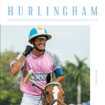As with any sport, competition at the highest level allows the game to evolve to the next level. Polo itself has developed as new clubs have grown and new tournaments have been established. Polo’s tournaments also show the history of polo and how its popularity spread.
England
The Westchester Cup
The international series between Great Britain and the United States is a good example of a tournament that has driven the sport forward.
The initial series in 1886 featured an energetic American team and a veteran British side. Captain John Watson and his Hurlingham team not only showed the Americans the benefits of superior horsepower, but also the benefits of team play and discipline. His introduction of the backhander to the game revolutionized polo, as the Americans had never seen it used before, and his sending the No. 1 against the opposing back and leaving the ball for the No. 2 and No. 3, was a strategy the young Americans had never considered.
In Newell Bent’s American Polo (The Macmillan Company, 1929), he reports that the “American ponies were excellent in some respects, resembling the Maltese barbs that came as polo ponies to England, only bigger and stronger and faster, and quite as handy.” But as handy as these American mounts might have been, they were outclassed by the speed of their British counterparts.
In 1886 the American matches consisted of three 20-minute chukkers with a 10-minute intermission between each period. There was also allotted a two-minute rest between scores. For the opening of the game, the ball was placed at the centre of the grounds and a selected player from each side would race to the centre to take control of the ball. The opening ball was captured by 17-year-old Foxhall Keene, who carried it the length of the field and scored with but 24 seconds gone. The band struck up Yankee Doodle, and the partisan crowd cheered, but the match had just begun.
From that time on, the play began in the middle of the field following a goal, and the British team took every advantage of their individual and team responsibilities. F. Gray Griswold did a good job summarizing the first series in his book (The International Polo Cup Duttons, New York, 1928) when he wrote: “The Americans played brilliant individual polo, but with little system or team- play. Against this the British passed the ball to one another, sacrificing individual to team-play and skilfully backhanded the ball. This play nonplussed the Americans, so that the Englishmen had little difficulty in winning the cup.”
For more information click here…
For past winners click here… see page 28 of the Blue Book
Coronation Cup (England) was presented in 1911 by the Ranelagh Club to commemorate the coronation of King George V. Years later, the cup was played for by the winners of the Hurlingham; Ranelagh and Roehampton Open Championships and the Regimental Tournament, a format that remained in place until 1939. The cup was revived in 1951 when it was contested in a series between Hurlingham and a visiting Argentine team. In 1953 it was played between teams from England, the United States, Argentina, Chile and Spain. The cup sat idle again until 1971 when it became an annual international match between England and different visiting international teams.
Cowdray Park Gold Cup was created in 1956 and is the emblematic of the English season championship. Played at Cowdray Park, the tournament marks the apex of the British polo season. Mexico’s Carlos Gracida played on a record 10 winning Gold Cup teams from 1987 to 1997. United States Open Championship (US) has been played since 1904 and is the highest level of polo competition in the country. Once played as a true open tournament, a handicap was assigned to the trophy following World War II in an effort to allow young up-and-coming players an opportunity to participate.
Queen’s Cup was donated by Queen Elizabeth II in 1960. Played at The Guards Polo Club, it is the second most important tournament in England after the Cowdray Park Gold Cup. It is currently being played at the 22-goal level. The popularity of the tournament has seen the number of teams swell over the years with international players from a score of different countries and team entries coming from as far away as Australia.
For past winners click here… see page 31 of the Blue Book
International Polo Tournaments
Argentina
Campeonato Abierto de Tortugas (The Tortugas Open-Argentina)- the cup was presented for play in 1907 by don Emilio de Anchorena. After 1972 it was played in conjunction with the San Martin Cup and the 12 de Octubre Cup. It is currently presented to the winner of the Tortugas Open Championship and is the first leg of the Argentine polo Triple Crown. The tournament is an open competition and has attracted 40-goal teams in the past. In 2009, the field attracted two 40-goal teams for the first time in history.
Campeonato Abierto de Hurlingham (Hurlingham Open-Argentina)-began in 1929 as the Senior Championship, according to Horace Laffaye’s Polo Encyclopaedia, its name was changed a few years later. The Hurlingham Open is the second most prized competition in Argentina. The Hurlingham Open is the second leg in the Argentine Triple Crown of polo, and directly precedes the Argentine Open. Like the Tortugas Open, the Hurlingham Open is played without handicap on a truly open format. Campeonato Abierto Argentino (Agrentine Open-Argentina) has been played for since 1923, the successor of the Polo Association of the River Plate Open, which dates back to 1893.
The final leg of the prestigious Argentina Triple Crown, The Argentine Open is considered the most coveted trophy in the game of polo today. The names of past winners read like a Who’s Who of polo. Played on the Argentine Polo Association’s grounds at Palermo in Buenos Aires, crowds of over 40,000 spectators that include representatives from the international polo community clamor to watch the very best of the best in this high-handicap competition.
United States of America
The U. S. Open is currently being played at the 22-goal level. The U. S. P. A. Gold Cup (US) was established in 1974, and is the second most prestigious trophy in American polo. Played at the 26-goal level, the Gold Cup is the precursor to the U. S. Open Championship. Played just before the Open Championship at the International Polo Club in Wellington, Florida, the Gold Cup serves as the second leg of America’s Triple Crown of polo.
The C. V. Whitney Cup (US) was established in 1979 and initially served as the handicap portion of the U. S. Open. It was later established as a single elimination tournament preceding the USPA Gold Cup and the US Open. It is currently being played at the 26-goal level and serves as the first leg of the American Triple Crown of polo.
The East Coast Open was founded in Rhode Island in 1905 and was played continuously until World War I. It had a renaissance starting in 1978 when Donald Little, then President of the United States Polo Association and Captain of the Myopia Polo Club, resurrected the tournament and brought it to Myopia Polo Club in South Hamilton, Massachusetts where it was played until the early 2000’s. Through its history, some of the best players in the world including many 10 goal players (the highest possible handicap) such as Mariano Aguerre, Mike Azzaro, and Gonzalo Pieres, Sr. have played and won this tournament and inspired many of today’s players to pick up their mallets.
Since 1905, the Perry Cup trophy has symbolized this high-goal championship and was donated by Mrs. Marsden Jaseal Perry – wife of a respected businessman, well-known clubman and owner of the largest Shakespearian library in the United States – for the competition. It was designed by noted American sculptor Oscar L. Lenz and the silversmith was Gorham Manufacturing Company in Rhode Island. The cup has recently been restored and made its debut at Greenwich Polo Club last year.
Six teams competed in the 2015 East Coast Open at Greenwich Polo Club in Greenwich, CT (a quick drive from New York City). Audi Polo won the final match in sudden death overtime, beating favorite White Birch. Thousands of fans watched the East Coast Open in Greenwich, plus all games were streamed online at ChukkerTV.com and the final was broadcast to an audience of 180,000 fans on NBC Sports Network.
In 2016, the world’s best polo players will again descend on the town of Greenwich, Connecticut to compete in the East Coast Open for the illustrious Perry Cup to determine which names will join the polo greats etched into the storied trophy.
The Camacho Cup
Named after General Avila Camacho, President of Mexico, 1940-1946, and an avid polo player, the cup was inaugurated in 1941 as a perpetual challenge trophy and has played for on eight different occasions. Early competition success favoured the United States as it won the first five series led by Michael Phipps and Cecil Smith, Winston Guest and Stewart Iglehart, Laddie Sanford and Dutch Evinger. Later U. S. teams would include Red Armour and Allen Scherer. The free ride ended in the 1976 contest, however, when Guillermo Gracida, Jr. joined his father on the team that scored three straight wins over the United States in Houston, Texas. Five years later the series was revived at the Retama Polo Center in San Antonio, Texas where Memo, Carlos and Ruben Gracida were joined by Pablo Rincon Gallardo as they downed the Americans in two of three games. The U.S. fared no better in a one game competition in 1988 at Palm Beach Polo and Country Club with Roberto Gonzales replacing Gallardo as Mexico kept the cup on the strength of a 9-6 victory. This year will mark the ninth playing for the cup, and the first Camacho Cup play in 21 years. Brothers Memo and Carlos Gracida are that much older, but can the youth and athleticism of the young Americans overcome the Mexican bank of experience.
Others
Coupe d’OrIDeauville Gold Cup (France) was created in 1951 and is played at the Deauville Polo Club. Annually attracting international players of the highest level, the Deauville Gold Cup is one of the most coveted prizes on the European continent.
The Indian Open boasts a trophy over 100 years old and a competition that traces its roots back to Calcutta in 1900. The official National Championship of Indian Polo, the tournament was moved to New Delhi in 2002 where it has remained. For decades Indian polo produced some of the games top players, and it was at the Indian Open that these players were at their best.


